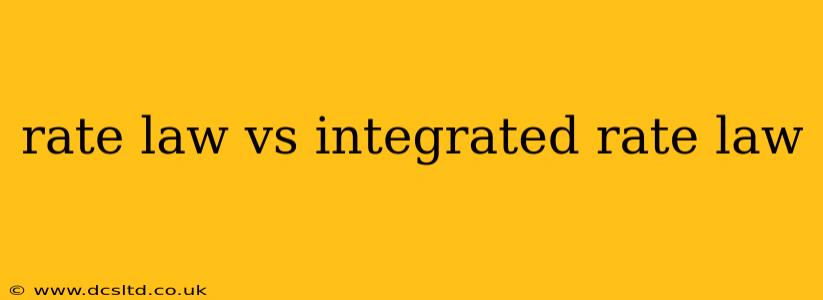Chemical kinetics is the study of reaction rates, exploring how fast chemical reactions proceed. Central to this study are two crucial concepts: the rate law and the integrated rate law. While closely related, they offer distinct perspectives on reaction dynamics. This article will clarify the differences and applications of each.
What is a Rate Law?
The rate law, also known as the differential rate law, expresses the relationship between the reaction rate and the concentrations of reactants. It's an experimentally determined equation that shows how the rate changes as reactant concentrations change. The general form is:
Rate = k[A]m[B]n
Where:
- Rate: The speed at which the reaction proceeds (e.g., M/s).
- k: The rate constant, a proportionality constant specific to the reaction at a given temperature. It reflects the intrinsic reactivity of the reactants.
- [A] and [B]: The concentrations of reactants A and B.
- m and n: The reaction orders with respect to reactants A and B, respectively. These are experimentally determined exponents, not necessarily equal to the stoichiometric coefficients in the balanced chemical equation. They describe how the rate changes as the concentration of each reactant is altered.
Example: If the rate law is Rate = k[A]2[B]1, it indicates a second-order reaction with respect to A, a first-order reaction with respect to B, and a third-order overall reaction (2 + 1 = 3). Doubling the concentration of A would quadruple the rate (2² = 4), while doubling the concentration of B would double the rate.
What is an Integrated Rate Law?
The integrated rate law is derived mathematically from the rate law. It expresses the concentration of a reactant as a function of time. This is incredibly useful for predicting the concentration of a reactant at any given time during the reaction, or determining the time required to reach a specific concentration. The form of the integrated rate law depends on the order of the reaction.
Here are examples for common reaction orders:
- Zero-order reaction: [A]t = [A]0 - kt
- First-order reaction: ln[A]t = ln[A]0 - kt or [A]t = [A]0e-kt
- Second-order reaction: 1/[A]t = 1/[A]0 + kt
Where:
- [A]t: Concentration of reactant A at time t.
- [A]0: Initial concentration of reactant A at time t=0.
- k: The rate constant (same as in the rate law).
- t: Time.
What is the Difference Between Rate Law and Integrated Rate Law?
The key difference lies in their representation of reaction kinetics:
| Feature | Rate Law (Differential Rate Law) | Integrated Rate Law |
|---|---|---|
| Representation | Relates reaction rate to reactant concentrations. | Relates reactant concentration to time. |
| Form | Rate = k[A]m[B]n | [A]t = f(t, [A]0, k) |
| Use | Determines reaction order and rate constant. | Predicts reactant concentrations at various times. |
| Derivation | Experimentally determined. | Derived mathematically from the rate law. |
Essentially, the rate law tells how fast the reaction is happening, while the integrated rate law tells how much reactant remains at a given time. They are interconnected; you need the rate law to obtain the integrated rate law.
How are Rate Laws and Integrated Rate Laws Determined?
Rate laws are determined experimentally by measuring reaction rates at various reactant concentrations. The integrated rate law is then derived mathematically based on the determined rate law and the reaction order. Graphical methods (plotting concentration vs. time, ln(concentration) vs. time, 1/concentration vs. time) are commonly used to determine the reaction order and rate constant.
What are the Applications of Rate Laws and Integrated Rate Laws?
Both rate laws and integrated rate laws have extensive applications in chemistry, including:
- Reaction mechanism elucidation: Rate laws provide clues about the elementary steps involved in a complex reaction.
- Process optimization: Understanding reaction kinetics helps optimize industrial chemical processes.
- Drug development: Pharmacokinetics uses rate laws and integrated rate laws to understand drug absorption, distribution, metabolism, and excretion.
- Environmental chemistry: Rate laws are crucial for modeling pollutant degradation and transformation in the environment.
By understanding both rate laws and integrated rate laws, we gain a comprehensive understanding of chemical reaction kinetics, enabling predictions and control over reaction processes in various fields.
